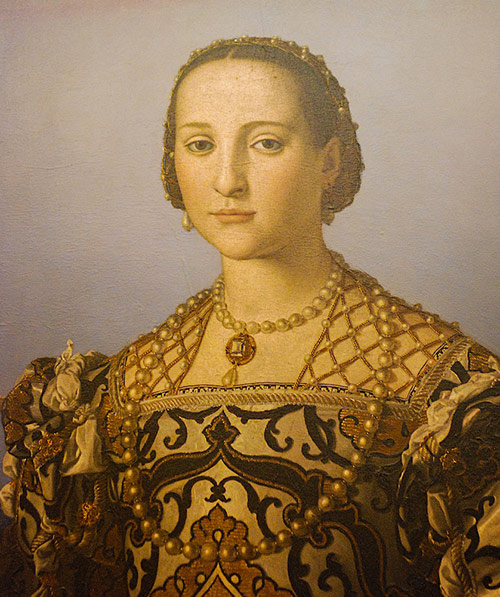
The colour always favoured by Eleanor was red, and the entrance to this exhibition devoted to her life and patronage, which has just closed at Palazzo Pitti, was hung with a sumptuous crimson curtain. Beyond it, the visitor was at once confronted by what at first glance seemed to be the most famous portrait of Eleanor and her son, by Bronzino, but on closer inspection it turned out to be a good replica made some 40 years later by a pupil, the little-known painter Lorenze Vaiani, or Lo Sciorina. He replaced the portrait of Eleanor’s son Giovanni with another son, Garzia. The significance of giving this work pride of place as an introduction to the exhibition is that it demonstrates how Eleanor’s image was often replicated to perpetuate her importance as a member of the Medici court.
Two Utens lunettes, from his famous series of paintings of the Medici villas around Florence, depict Poggio a Caiano (with its garden and extensive estate) where Eleanor was received on her arrival in the city, and which remained her favourite residence, as well as the place where she chose to rest before the birth of each of her eleven children. The lunette of the Boboli behind the Pitti reminds us of how much Eleanor did to create that famous garden, ten years after she had married Cosimo I de’ Medici in 1539. It was her immense wealth that enabled her to purchase Palazzo Pitti and the park behind it.
Eleanor’s family background was Spanish: on loan from the Alte Pinakothek in Munich came an imposing portrait of her father, Don Pedro de Toledo, Viceroy of Naples. Holding a long pilgrim’s staff, symbol of the Spanish military order of the Knights of Santiago, the portrait has been attributed to Titian. The beautiful marble statue of a young river god, by Pierino da Vinci (now in the Louvre), was a gift from Eleanor to her father. Many ancient Roman statues, often reworked or restored by 16th-century sculptors, were chosen to adorn the Boboli gardens. Alongisde these, there were a number of much less pretentious ones, recording ordinary farmers about their work. These were a particular feature of the gardens which were largely created by Eleanor, and a genre sculpture of a peasant emptying a small barrel (designed as a fountain), which was part of the exhibition and is now replaced in the gardens by a copy, is known to have been specially commissioned by her from Baccio Bandinelli (his was the design but not the execution). The peasant, dressed in his work clothes, has a very expressive face and he introduced an entirely new type of sculpture to populate Italian gardens, a type which was to remain a feature of all subsequent formal gardens of this kind.
In quite a different spirit, Bandinelli was also responsible for the pair of small bronze busts, very refined portraits of Eleanor and Cosimo. The couple are also depicted, with five of their children, in a precious little agate cameo made by Giovanni Antonio de’ Rossi (displayed beside a drawing of it by Vasari from Christ Church, Oxford).
The most magnificent portraits of Eleanor and her husband, however, are those by Bronzino, and it is he who was inevitably the star of the show. His portraits are all still in Florence, including some very small portraits of the children, in oil on tin. He also possessed extraordinary skill as a draughtsman, producing studies for the chapel in Palazzo Vecchio which he painted for Eleanor.
It is known that Eleanor kept two weavers at her court and some very fine 16th-century tapestries survive.
Also part of the show were Eleanor’s exquisite little Book of Hours (now in the V&A in London) and a very small Deposition by Gérard David (1515–20), which is in the Uffizi but not normally on view and is thought to have been owned by Eleanor’s mother. Some of the most precious pieces of jewellery were fashioned by setting engraved Roman gems in gold mounts worked by Florentine jewellers. Two rings found in Eleonora’s tomb (opened in 1947) are Roman but refashioned by a Florentine craftsman, and almost certainly commissioned by Eleanor herself.
Also found in Eleanor’s tomb was a corset and pair of knitted stockings, both in her favourite red, apparently worn in her lifetime to keep her warm and taken with her to the tomb for the same purpose (she died of malaria in 1562). Displayed close by was an alarming steel corset which we are told she also wore on occasion.
The closing images were a pair of oval portraits of Eleanor and Cosimo, carved in maroon and green porphyry, an exceptionally hard rock occasionally used for imperial portraits in ancient Rome: these are certain to perpetuate for all time the couples’ remarkable lives.
by Alta Macadam, author of Blue Guide Florence






